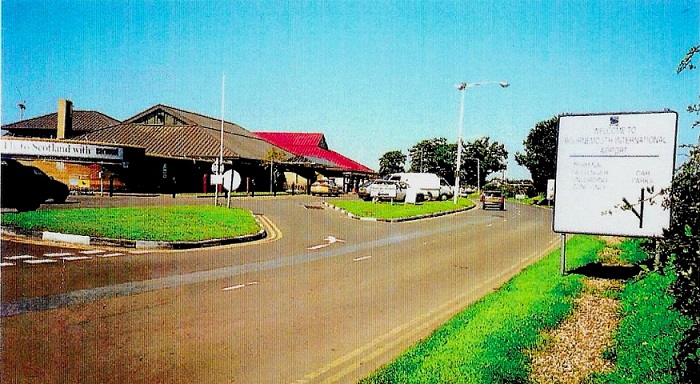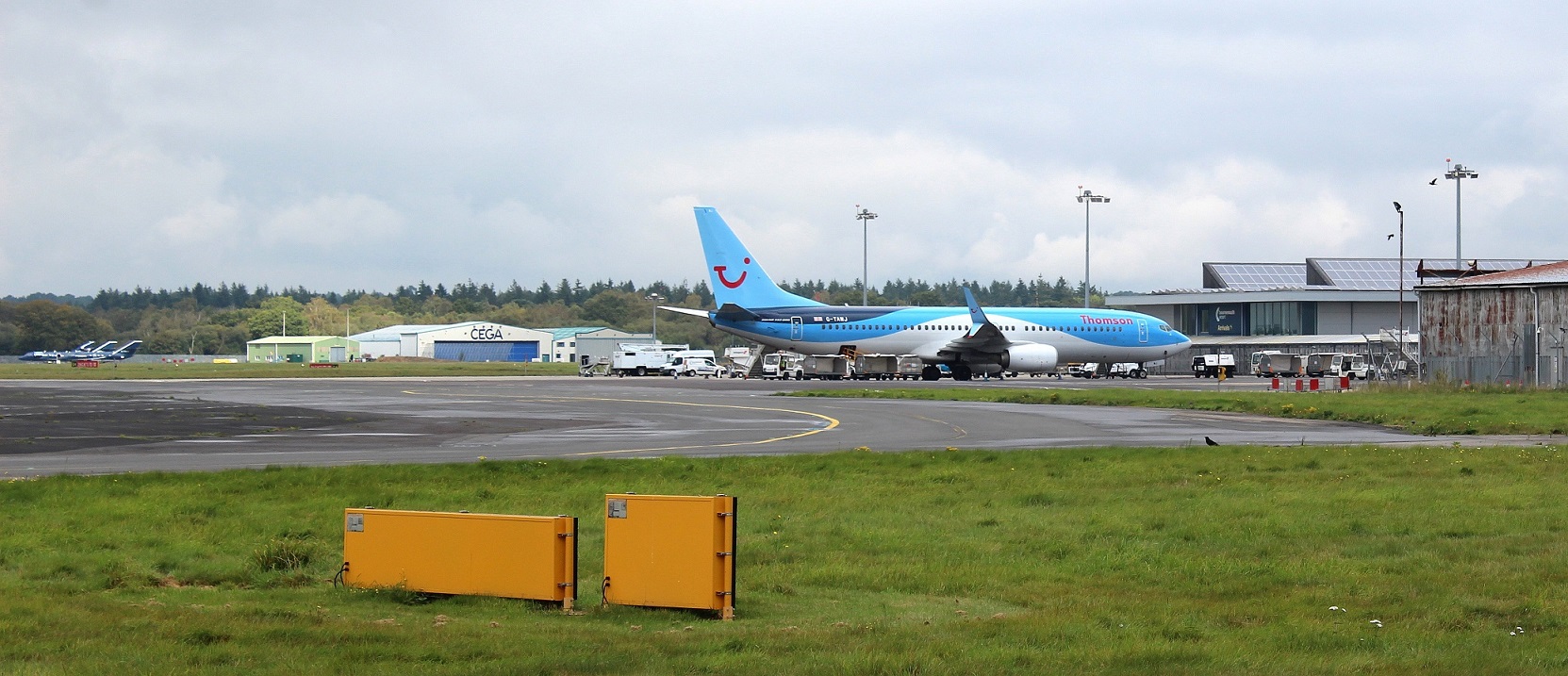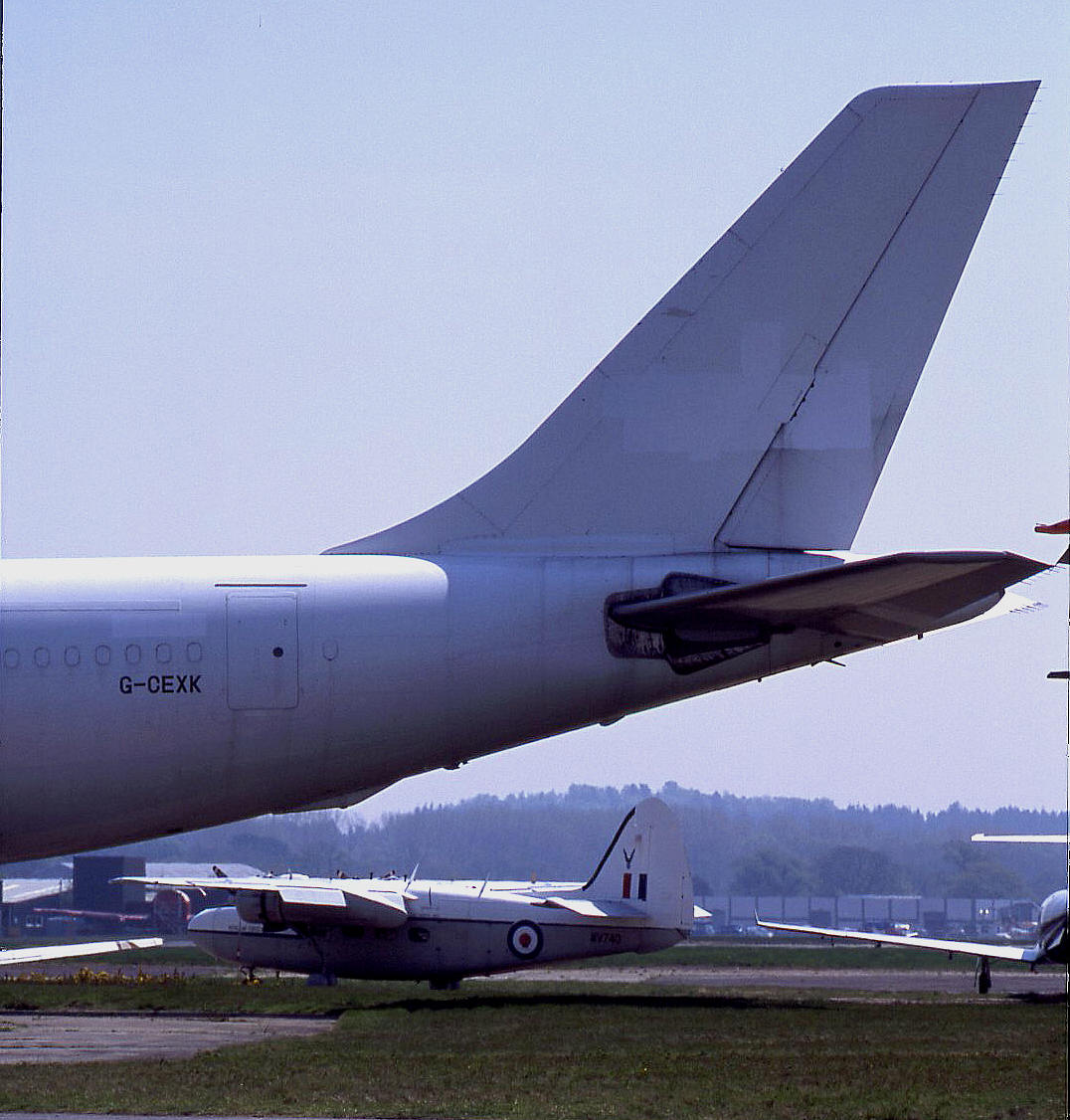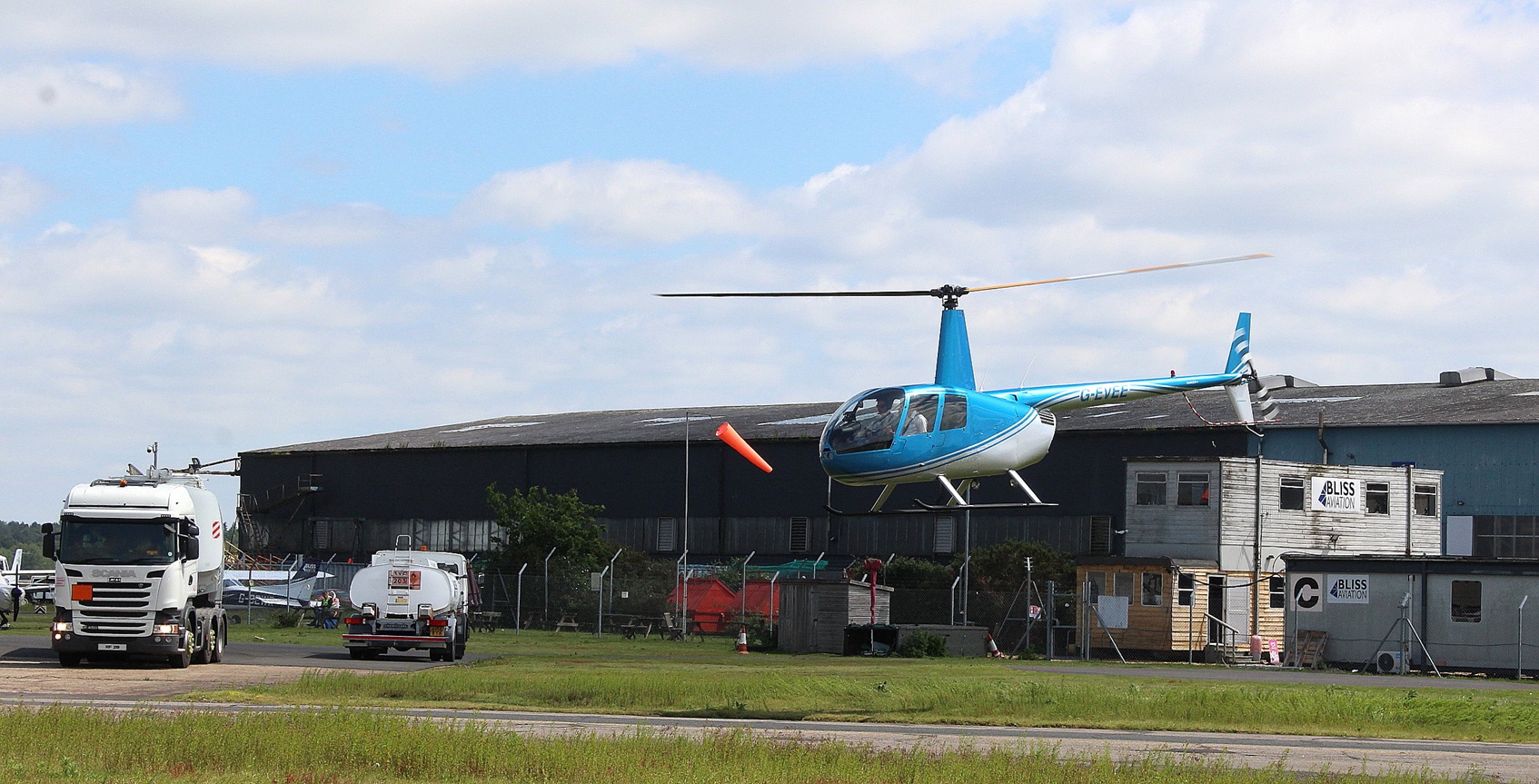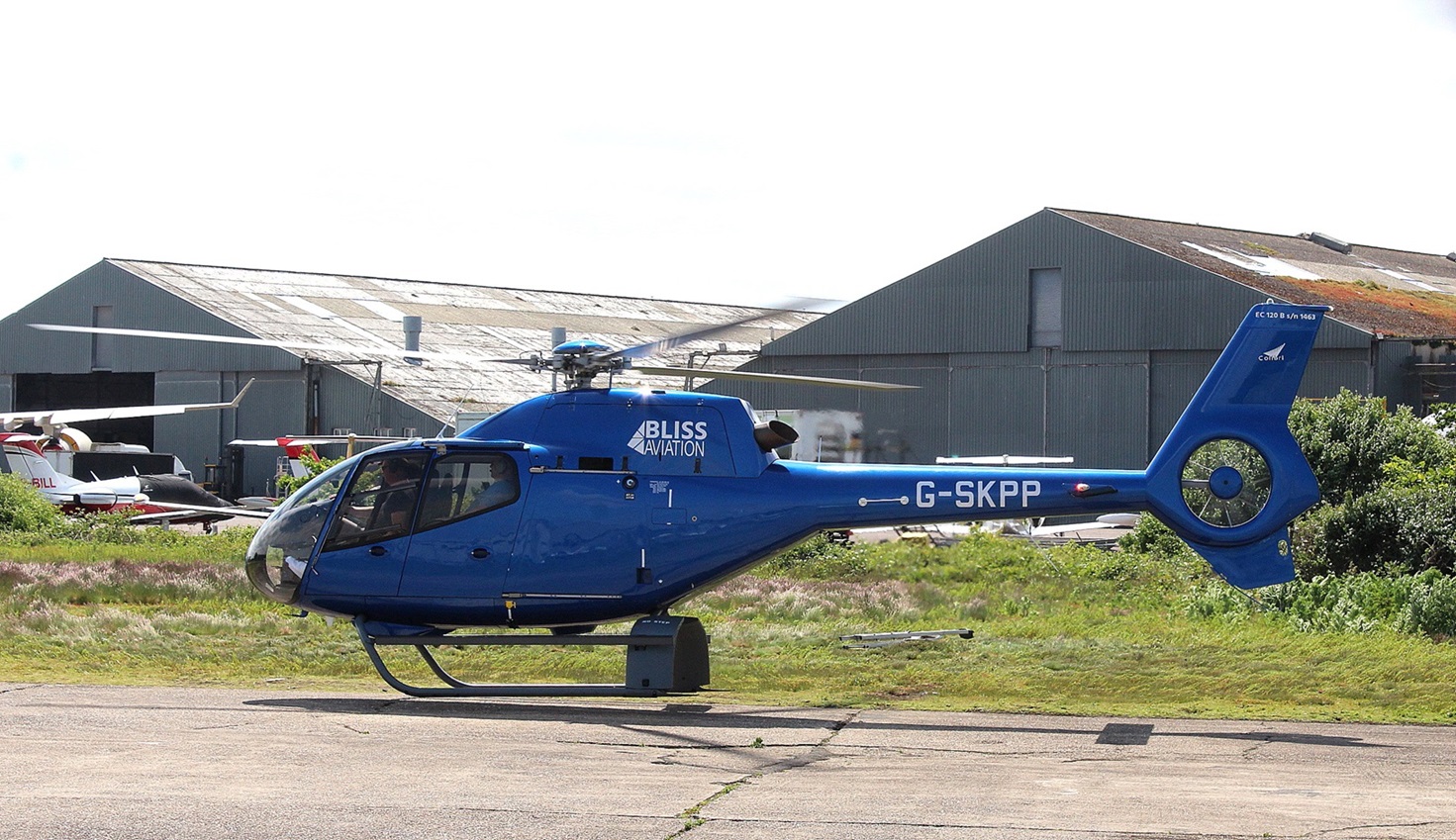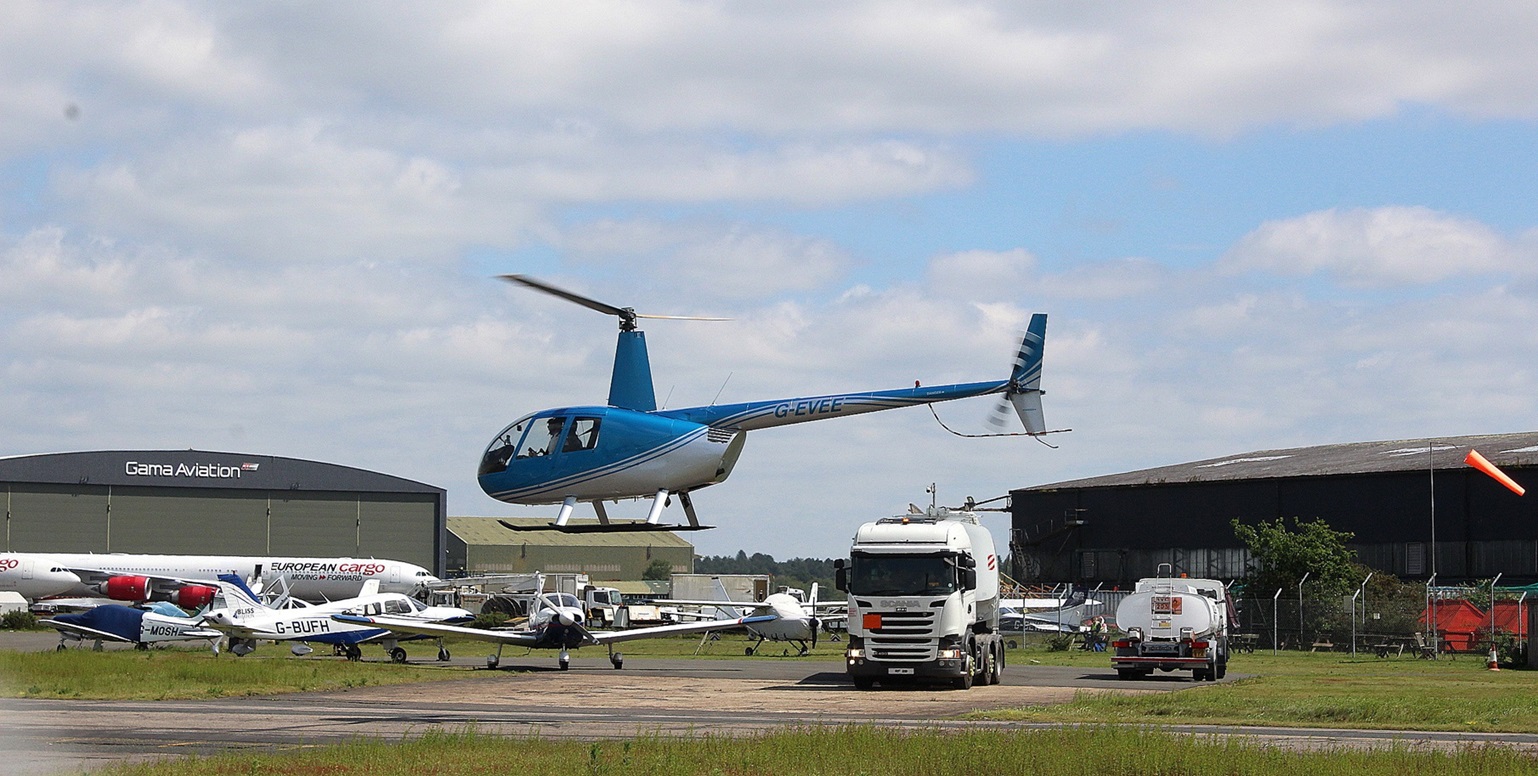Bournemouth International Airport
BOURNEMOUTH INTERNATIONAL AIRPORT: Military aerodrome later civil regional airport. (Previously known as HURN and often listed as being in DORSET which today, it is. Prior to 1974 this airport was in HAMPSHIRE)
For some WW2 history see HURN (HAMPSHIRE)
Note: All pictures by the author unless specified.
ICAO code: EGHH IATA code: BOH
Operated by: 1990: Bournemouth (Hurn) Airport plc
2000: Bournemouth International Airport Ltd
Military users: For WW2 history see HURN
1980s: 2 AEF (Chipmunks)
A MIKE CHARLTON GALLERY
These pictures, from postcards, were kindly sent by Mike Charlton who has an amazing collection. See, www.aviationpostcard.co.uk
Note: The top picture of the first postcard, from three probably all taken in the 1990s (?), is very interesting I think. In the foreground is the Gill-Air ATR 42-320, then a Channel Express Handley Page Herald, a Partenavia P68, a Palmair BAe146. But, beyond is the tail of a Lockheed C-130 Hercules. Can anybody kindly provide advice on this visit?
Second picture: As said, I am only guessing that this picture was taken in the early 1980s? Certainly before the first 'proper' terminal was opened. If anybody can kindly offer advice, this will be most welcome. As far as I can make out, from top to bottom on the west side of the apron, the first is a Boeing 737 presumably operated by Palmair, then three Dan Air airliners, the first being a Hawlers-Siddeley HS748, then two versions of the BAC One-Eleven. Over on the right is a Handley Page Herald, probably operated by Channel Express.
Third picture: This is of the first 'proper' terminal, and it seems quite difficult to ascertain when this opened. My guess is the mid to late 1980s? The sign says 'Bournemouth International Airport' so perhaps the change of name occurred around the same time? Once again, any advice is much appreciated.
Fourth picture. Once again I would appreciate advice, but I strongly suspect that this picture was taken in 1996 when Bath Travel organised two flights in Concorde.
Activities: Post 1945: Airline, air freight, charter, GA air taxi, private, training and large scale maintenance base for light to heavy aircraft. Once manufacturing took place and today it is also a base for older military jets in civil use
British airline users: WW2: BOAC
Post 1945: Air Safaris, Aurigny Air Services, Astraeus, Barclays International Airways, BKS, Blue Islands Airline, Bournair, Britannia Airways, British Airways (Cambrian), British Island Airways, British Midland Airways, British United Airways, Cambrian Air Services, Channel Airways, Channel Express, Dan-Air, Derby Airways*, Flightline, Intra Airways, Jersey Airlines, J F Airlines (Aka JFA), Palmair, Small Planet, Thomson-fly, Thompson-Jet
Foreign airlines: WW2: KLM, Sabena
Post 1945: Ryanair, Wizz Air
Car ferry: Silver City (Bristol Superfreighters)
A SINGULAR OPERATION
But, (a question asked in 2017), is it still based here?
AIR CARGO
Note: It appears that Channel Express initially adopted the Express Air Services (EAS) name in 1978 and obtained the contract from the Post Office in the early 1980s, before becoming Channel Express in 1983. Which puts a four year time-scale on this postcard picture.
What I found interesting looking more closely at this postcard in 2017, (I now have no idea when and where I obtained it), is that it was issued as; "A Post Office Picture Card". The caption reads: "Bournemouth Royal Mail Air Services Postcard - Mail from many centres in the UK is flown to Speke Airport nightly and interchanged for the return flights around 2 a.m. Mail from Dorset, Hants and Wilts is flown from Bournemouth and letters for delivery to these areas are carried on the return flights."
Clearly the first three aircraft depicted on the postcard are the Handley Page 'Dart Heralds' operated by EAS, but the fourth is an Armstrong Whitworth AW.660 Argosy - a type which I am pretty certain was never operated by EAS. I am fairly certain that the Argosy was operated by Elan Parcel Service, and being a tad nerdy, was this a charter by EAS or a seperate Royal Mail contract? And indeed, the caption on the postcard says it is a "Mail plane at Speke."
But I wonder, if this is really correct, what utter dimwit decided to include it on a postcard celebrating Royal Mail services from Bournemouth!
The sheer complexity of commercial air operations within the UK is something a simple 'Guide' such as this cannot possibly hope to address in detail. But, if you are interested in seeing a picture of an Elan Parcel Service AW.660 Argosy, please see my article regarding 'British Aircraft Museums' and scroll down to DONNINGTON AEROPARK.
Air cargo: Post 1945: Channel Express (Aka Express Air Services - EAS)
Aviation museum: Adjacent to the airport, on the south side, there has been for several years, an aviation museum.
Charter, air taxi: Post 1945: Air Bridge Carriers, Air Safaris, Alderney Air Charter, Blue Air, Bournair, British Caledonian Airways, British Westpoint Airlines, Cannon Aviation,Channel Airways, Derby Airways, European Aviation Air Charter-EAL, Independent Air Transport, Island Air Charter, Macedonian Aviation
Note: The Boeing 737 9H-AJW (registered in Malta) was one of two 737s operated by Maleth-Aero and based here during 2016/17. (Possibly earlier?). This 'plain-wrapper' 737 is one of a sizeable "ghost-fleet" available around the world for hire or lease, even for a very short period, to take up the slack for all kinds of airline operators.
These will range from major scheduled carriers to holiday charter companies, many of whom do not actually operate aircraft. For example, to fill a sudden gap in the schedule when one of their aircraft (or a hired aircraft) suddenly goes 'tech' on a serious issue, or is involved in an airframe damage incident/accident - or to meet sudden peaks in demand.
And, it has to said, the majority of people flying today could not care less about whose aeroplane they are stepping aboard - providing the ticket price suits their budget. This said, with safety standards rising ever upwards, by and large, who can blame them.
INDEPENDENT AIR TRANSPORT
These two pictures were also kindly sent by Mike Charlton and are redolent of the age when the I.T. (Inclusive Tour) operators were flourishing. Although registered at HURN it appears that their main operating base was actually BLACKBUSHE (HAMPSHIRE), and HURN was mostly their maintenance base.
Independent Air Travel was formed in 1954, initially with the Anson G-ALUM (ex MG901), and two DH104 Doves were soon added. I don't know when the name was changed to Independent Air Transport. In 1956 four ex-BWIA (British West Indian Airways) Vikings arrived, followed by a few more. In July 1957 the first Douglas C-54 was acquired with two more arriving in mid 1958. In 1959 the name of the company was changed to Blue Air but the enterprise folded in October 1959.
The Independent Air Transport fleet was:
G-ALUM Avro Anson 1
G-APBX Beech C-18-S
G-AILW Bristol B170 Freighter 31
G-AHRJ & G-AKSS de Havilland DH104 Dove 1
G-APCW & G-APID Douglas C-54A Skymaster, G-APNH a C-54B example.
G-AKWJ Percival Proctor 3 (used for crew ferry duties)
G-AHPR & G-AJCE Vickers V610 Viking, G-AHPE & G-AHPG were V614 types, G-AIJE a V624 Viking, and G-AGRS & G-AHOU were V657 Viking types.
It appears that when Blue Air folded, the fleet was G-AJBU, a Vickers V610 Viking, the V635 Viking G-AMNR. And the Viking G-AJCE, Proctor G-AKWJ and the three C-54s from Independent Air Travel.
THE PICTURES AND A BIT OF HISTORY
Both taken without too much doubt at HURN both are captioned as Dougloas DC-4 73-seaters and they are nothing of the kind, being converted military transports. But, in fact there is nothing ostensibly sub-standard about these conversions, and indeed given the right treatment, they could in fact be equal to or even better equipped than the civiliian version. I suspect most weren't?
The first picture is of G-APCW, a Douglas C-54A Skymaster, ex-N93266 and first registered in the UK on the 5th July 1957 to International Air Transport at HURN. It served with them, it seems, until the 11th September 1959. Then going to Blue Air for about three weeks from the 20th October until the 9th November 1959.
G-APCW then went to Universal Sky Tours from the 19th February 1960 until the 15th December 1960. It then went to Trans-World Leasing at PANSHANGAR in HERTFORDSHIRE, a relatively small grass aerodrome but capable of handling this type of airliner. It then went to the Belgian Congo as 90-PCW - no doubt saving a bit of paint with the new registration.
Note: Picture by Austin J Brown:
Car ferry: Post 1945: British United Air Ferries, Silver City Airways
Pleasure flights: Pre 1940: Bournemouth Aviation?
Post 1945: Bournair, Cannon Aviation
Flying schools: Post 1945: Bournemouth Commercial Flight Training Centre, Bournemouth Flying Club, Bournemouth Helicopters, Cannon Aviation, Professional Air Training, Solent School of Flying, Speedbird Flying Club, The Pilot Training College
Gliding: 1981: B.A.C. Flying and Gliding Club
Helicopter ops: Bournemouth Helicopters, Red Aviation Helicopters
Maintenance: Air Safaris, Airwork Services, Cannon Aviation & Glos Air
Note: In the 1970s at least, Glos Air undertook the maintenance of Aurigney Air Services Islander and Trislander fleet.
Manufacturing: Vickers-Armstrong, British Aircraft Corporation later British Aerospace (Closed 1984)
Other users: Airwork (Canberras & Hunters), FR Aviation on RNAS contracts, Jet Heritage
Note: Picture from the John Stroud Collection.
Training base: Post 1945: British Overseas Airways Corporation (BOAC) until 1957? Possibly later?
Location: 4 nm NNE of Bournemouth
Period of operation: Military from 1940/41 to 1944. Civil from 1944 to present day.
Note: This maps are reproduced with the kind permission of Pooleys Flight Equipment Ltd. Copyright Robert Pooley 2014.
Runways: WW2: 08/26 1829x46 hard 17/35 1463x46 hard 12/30 1033x46 hard
1959: 08/26 1838x46 hard 17/35 1463x46 hard
1990: 08/26 1838x46 hard 17/35 1476x46 hard
2000: 08/26 2271x46 hard 17/35 850x23 hard
NOTES: THE 1940s
In the excellent book The War in the West by James Holland, the second in a triology, he describes how General Eisenhower, "finally left Bournemouth for Gibraltar in their fleet of B-17s." This was when Eisenhower was destined to take overall command of operation TORCH, the invasion of north-west Africa in 1942.
What I think is probably little known about today, is that before HEATHROW (LONDON AIRPORT) was opened in 1948, HURN was the trans-Atlantic airport for London! It appears that BOAC moved here from WHITCHURCH (SOMERSET) in late 1944 and commenced both trans-Atlantic and services to the Far East in 1945. Using it appears, for long-haul flights, Avro Lancastrians, a very basic civil conversion of the WW2 Lancaster bomber.
And, it seems, Pan Am commenced a five-day a week scheduled service from La Guardia airport serving New York, using the Douglas DC-4. Flight times were expected to be around 17 hours and 40 minutes. For younger readers especially, it needs to be explained that, compared to flying in a Lancastrian, the option offered by Pan Am flying in a DC-4 really was quite luxurious travel. A wonder what the difference in fares was?
Also, none of these airliners could fly direct, and at least two en route stops were required. Typically, Gander in Canada, then either PRESTWICK in Scotland, or Shannon on the west coast of Ireland.
THE 1950s
Three De Havilland MkXVI Mosquito’s were overhauled here in the 1950s before being sold to the Isreali Air Force. In September 1950 an air race meeting was held here and these were usually two day events! In fact it was quite common for these races to be held at regional airports which would today of course be quite impossible I suppose for various reasons, the main reason being they’ve became so much busier.
In these days of simulator training it has to be remembered that all airlines once had to use ‘real’ aircraft for training and BOAC for example used HURN as well some other airfields such as FILTON (?) and ALDERMASTON. At HURN the BOAC conversion courses for the Canadair C-4 Argonaut and Handley Page Hermes were held here in the early 1950s.
TAILS OF THE FIFTIES
In the Tails of the Fifties, the first of three anthologys compiled by Peter G Campbell. Peter Amos tells us that in 1949 the Speedbird Flying Club was available to people working in BOAC, BEAC and BSAAC operating two Miles Hawk Trainers, G-AKKS and G-AKKV. Also in those days a very interesting group of BOAC types were evident. Apart from the Canadair Argonauts and Handley Page Hermes a number of Avro Lancastrians and Avro Yorks were present. On top of these, on the 17th August 1949 an Avro Tudor was in storage - belonging to whom? Five MCA Airspeed Consuls plus a DH104 Dove were logged. The BOAC Argonauts and Hermes were undertaking crew familiarisation training which in those days involved a lot of circuit bashing.
THE VICKERS COMPANY PRESENCE
In 1951 Vickers-Armstrong centred Viscount production here, and, when they became in turn the British Aircraft Corporation the BAC One-Eleven airliners were also built here. By 1959 commercial airline operations were it seems pretty sparse, Jersey Airlines offering services to Guernsey and Jersey and both Airwork and Blue Air, (the latter having their DC-4s labelled Independent Air Travel), had bases here. Presumably the larger proportion of this traffic being during the main holiday seasons?
Perhaps one detail not generally known is that after the prototype Vickers 660 Valiant ‘V-Bomber’ WB210, (a term coined in 1952), had made some initial flights from WISLEY (SURREY) which was still a grass airfield in 1951, it was then decided that a hard runway at WISLEY would be a better idea. Whilst this construction was taking place WB210 was flown to HURN. Flight testing continued at HURN until, on the 12th January 1952, when undertaking engine shutdown and relight trials a severe fire in an engine bay forced the crew to escape. All survived except Squadron Leader Brian Foster whose ejection seat struck the tail fin.
THE PARANOIA OF CUSTOMS & EXCISE
*In the 1950s the British authorities, especially Customs and Excise, were virtually paranoid regarding the major threat to the mainland posed by the Channel Islands. I have yet to discover exactly what this threat was, but it was sufficient to require every airliner departing from a non-Customs controlled airport to land en route for Customs clearance. Initially this had to be done both outbound and inbound but in the mid-1950s this was relaxed to inbound flights only. Take for example Derby Airways whose flights from BURNASTON (Derby), PENDEFORD (Wolverhampton), SYWELL (Northampton), TEVERTON (Cambridge), STAVERTON (Gloucester/Cheltenham) and LUTON had to land en route at ELMDON (Birmingham) or EASTLEIGH (Southampton) or HURN (Bournemouth) to clear Customs controls.
As far as I can work out some imbecile had concluded that the "devastation" which would be wreaked on the British economy by a family of holidaymakers or a honeymoon couple returning from the Channel Islands with a carton or two of cheap fags or a bottle or two of cheap booze over and above regulated amounts, clearly had to be severely controlled. To the extent of diverting every airliner to and from the Channel Islands. It all seems to be utterly bananas. Was there really anything else that posed such a huge threat to UK mainland security from the Channel Islands ?
A SMALL DETAIL FROM THE '70s
Lorry drivers where flown daily across to Cherbourg in the 1970s by Alderney Air Charter (due to lack of accommodation on the freight ferry) using a Cessna 337 Skymaster which in itself makes for a very unusual ‘airliner’. Presumably flying in nearly all weather conditions I wonder how the drivers felt about this? I would love to hear from one of those drivers and how they saw this part of their job.
AN OVERALL VIEW IN 1974
This seems well worth quoting from the book UK & EIRE Commercial Airports, published by Airline Publications & Sales Ltd.
"Hurn Airport, near Bournemouth, is served by only a small handful of scheduled airline flights: nevertheless with peak daily aircraft movements sometimes topping 900, many commercial and military types, up to VC-10 size, are to be seen here. A prominent feature of the airfield and its operations is the British Aircraft Corporation Hurn factory, currently engaged in production of their successful One-Eleven short-medium haul jet airliner, as well as the manufacture of nose sections and other components for the Concorde supersonic airliner."
"The present complex of aircraft production area was developed during the mid-1950s to help meet demand for the famed Vickers Viscount turbo-prop transport, and covers some 930,000sq ft of floor space."
"BAC aircraft already in service occassionally visit Hurn for refurbishment or modification work. Other activities embraces light and executive types - nearly 40 such aircraft are based on the airfield - military and commercial aircraft on training work, and a number of airline charters."
ANOTHER ASPECT OF AIR CHARTER
Note: The advert for South Coast Airways, based at BOURNEMOUTH, is copied from a brochure for the 'Lydd Classic Airliner Fly in & Classic Car Drive' held in 1996. Without any doubt we should admire anybody brave enough to try and establish a commercially successful enterprise operating an ex-WW2 military transport aircraft in the late 20th century - can there be a more deserving cause? Inevitiably I suppose, the insurmountable problems kept adding up, and it folded in 2002.
On reading the September edition of Light Aviation magazine in 2017, I was both surprised and pleased to see, in an article by Martin Ferid, that G-DAKK, (A Douglas C-47A shipped into the UK for use by the USAAF in 1944, and it appears taking part in both D-Day and Arnhem), has been preserved at the Aviodrome at Lelystad in The Netherlands.
ANOTHER NOTABLE EVENT
In 1996 it seems that a Leisure International Boeing 767-300 made the first trans-Atlantic flight from BOURNEMOUTH to the USA - the first in 50 years. This time, not to New York but Disneyland. How times have changed!
BOURNEMOUTH PICTURES
THE CANADAIR CL-44 'CONROY SKYMONSTER'
On a visit to Bournemouth airport delivering an aircraft from Luxembourg in November 2010 I was intrigued to see a group of people working on this aeroplane. I was told they were from The Netherlands and planned to make it airworthy so it could be flown to a museum, possibly the museum in/near Schipol airport, Amsterdam. Did they achieve that aim?
THE TWENTIETH CENTURY
In 2006 Bournemouth Flying Club had access to a SF.260, which was probably a unique opportunity for a non-owner to fly this type in the UK? Very few are on the UK register anyway. Designed by Stelio Frati for Aviamilano who produced a prototype which flew in 1964, it went into production with SIAI-Marchetti then Aermacchi. It says a lot for this superb, (but mainly military design of trainer), because it appears Aermacchi were still producing them in 2007. Perhaps not surprising BFC advertised price on application if you want to fly it!
In recent years this airport has developed beyond all recognition with a huge amount of diverse activities, not least the expansion of IT (Inclusive Tour) flight operators. Indeed even Jumbo-jets can be seen there!
A NOTABLE EVENT
On the 11th February 2006 BOURNEMOUTH came before the eyes of the world when Steve Fossett landed here breaking the World Record solo non-stop and un-refuelled distance record. He had taken off on the 8th from NASA’s Kennedy Space Center in Florida and landed here after 76 hours and 45 minutes having covered 26,389 miles in the Rutan designed Virgin Atlantic Globalflyer. The previous year he’d made the first World Record breaking solo non-stop and un-refuelled circumnavigation of the earth in the same aircraft. A consummate record breaker, he set 166 records in five sports or disciplines, (60 of which still stood in June 2009). His sudden and unexpected disappearance when flying in the Sierra Nevada mountains in the USA still has a large degree of mystery attached to it. It took a long time before the crash site was located and the remaining evidence didn’t make much sense towards explaining what had actually happened.
BOURNEMOUTH PICTURES IN JANUARY 2017
Just into the New Year 2017 I made another visit which suited my purposes admirably - the airport was almost deserted.
PERSONAL MEMORIES AND PICTURES
In May 2008 I was given the job of collecting the Vans RV6A G-TJDM, after it had been painted, for delivery to WHITE WALTHAM (BERKSHIRE).
The second picture is of the Grumman AA-1 G-AZKS which I collected from Coventry airport and delivered to the Airtime hangar in October 2010. The third picture is of my truck outside the Airtime hangar after delivering a Grumman AA-1 LX-ARS from Luxembourg International airport in November 2010.
Notes: G-AZKS was the aircraft that won the Schneider Trophy race in 1999.
A BRIEF VISIT IN EARLY JUNE 2024
Views from the southside.
The first picture is of G-ECLC (ex 2-EALK). registered to European Cargo Ltd, which now have a considerable presence here with a fleet of Airbus A340 freighters. The second picture of two TUI, 737-8KS airliners shows G-TAWA in the foreground, that being ex-C-FVWA).
Views of the northside.
The north side of BOURNEMOUTH AIRPORT has long been, for me at least, the more interesting. I have no idea about what exactly goes on here and it seems to be quite changeable in character over the last few decades.
Question? Regarding the first picture - are these aircraft for sale, for maintenance or for scrapping? I will happily admit that before seeing these two examples shown, 2-CAMP and 2-WEBS, I had no idea that aircraft could be registered seperate from the UK, in Guernsey. Then again, my reggie spotting days did end around sixty years ago.
The second picture of the Airbus A340-541 G-ECLF (ex 2-EALG), was registered to European Cargo 06.07.2023. Presumably awaiting to be repainted/modified/major maintenance? Picture three shows the Hawker Siddeley HS.125-700A, M-ALUN, and the Rockwell Commander 112TCA G-BFZM (ex N4661W). The fourth picture shows some European Cargo A340s lined up. Although the company is called European Cargo, can I assume these A340s are for global operations?
Helicopter pictures.
Whilst there thought it a good idea to get a couple or so pictures of helicopters operating.
The first and third pictures are of the Robinson R44 G-EVEE, and G-SKPP, (ex F-HAAL), just about to touch down, is an Eurocopter EC120B Colibri.
AS FOR THE FUTURE?
I do often pay visits to relatives in this part of the UK, so might well pay another visit with my snapometer, should the weather be kind enough.
Jon Radford
This comment was written on: 2019-03-13 08:26:07Some years ago, I recovered what I believe to be a war time RAF pilots perimeter cars from a collapsing nissen hut on the perimeter of what is now Bournemouth airfield. It is a 1930s Austin 7 with a radiator painted in the distinctive red & white squares. Most of the body work had rusted away but the original number plate was still attached to the front grille which has just about survived. The Hut was located near what is now the Air ambulance site on the North side of the field. Im wondering if you might have any pictures or further information about this car as I intend to do some restoration at some point and more info would be useful.
Reply from Dick Flute:
Hi Jon, I shall keep this request posted. Hopefully somebody can help? Best regards, Dick
Frank skinner
This comment was written on: 2020-10-04 22:31:47I joined BOAC at the age of 16 in the maintenance division on no 2 line York And also the development flight with a Lancaster g-Agni.some years later I was an inspector with Vickers viscount and later on with independent air travel.i have many memories of Hurn as it was.after all this I was with Iran air for 22years,leaving in 1982.many memories.
We'd love to hear from you, so please scroll down to leave a comment!
Leave a comment ...
Copyright (c) UK Airfield Guide

















